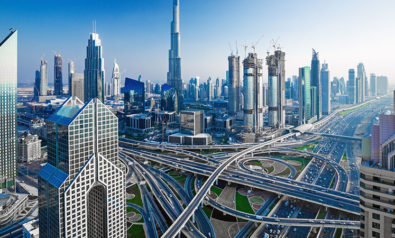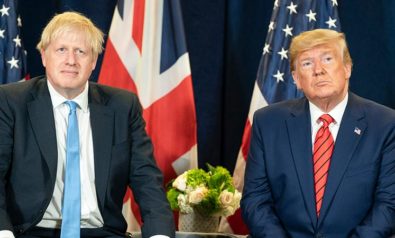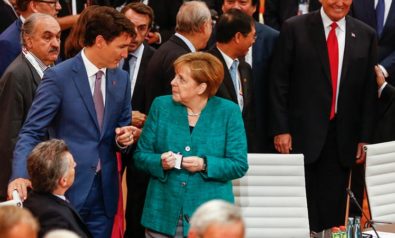With West Texas Intermediate futures trading in negative territory for the first time in history, it seemed the market had finally come to terms with what experts had long warned: The world is running out of oil storage. With human movement restricted due to the coronavirus pandemic, aviation grounded and the global economy halted, demand for oil plummeted.
By March, Saudi Arabia warned that the demand destruction that had started in the Asian market would spread. The Saudis reasoned that OPEC+ countries needed to undertake larger production cuts in order to balance the 30 million barrels per day in demand. Angered by US sanctions on Rosneft and the Nord Stream 2 project, Russia refused to give up market shares to the benefit of US shale oil. Saudi Arabia responded by flooding the market in a bid to strong-arm Russia back to the negotiating table. With both a supply glut and low demand, inventories are bound to reach maximum limits and push down prices even further.
COVID-19 and Low Oil Prices Threaten to Leave Saudi Arabia With Empty Hands
Saudi Arabia’s economy will suffer in the short term. The government has already trimmed the 2020 budget by 5%. Further spending cuts are expected. The International Monetary Fund (IMF) argued that Saudi Crown Prince Mohammed bin Salman would be wise to remove fuel subsidies — accounting for 17.9% of GDP — when gasoline is cheap, thereby avoiding political backlash. Instead, the Saudis adjusted the price by reducing the cost to consumers by over 50%, at least for May. Other decreases in public benefits risk undermining the social contract, which can alienate sections of the population that have given the crown prince staunch domestic support.
On May 10, King Salman bin Abdulaziz ordered a cut in Vision 2030 projects and other efforts by $26 billion, increasing value-added tax (VAT) from 5% to 15%, stopping the cost of living allowance to state employees and revising benefits of government contractors. These short-term painful cuts are expected to be reversed later in 2020, depending on how quickly the global economy adjusts to the new energy environment. Revenues from investments are plugging budget deficits, and the reserves from the Public Investment Fund (PIF) — Saudi Arabia’s $320-billion sovereign wealth fund — will cushion the macroeconomic crash. The $470 billion in foreign reserves provide an additional source of cash, but restraint is required in order to avoid currency pressure on the dollar-pegged riyal.
Saudi Arabia, like other Gulf Cooperation Council (GCC) member states, will carry forward with bond issuances. The kingdom has already sold $12 billion on international debt markets, and the government is willing to increase the debt-to-GDP level from 24% to 50%.
While the short-term economic forecast appears gloomy, the long-term outlook is brighter. It appears that a protracted low-price environment will continue forcing involuntarily shut-ins on petroleum producers. Oil fields around the world will contract permanent damage from shutting down production and, in many cases, they will not be able to resume extractions. Yet Saudi Arabia’s low-cost and flexible petroleum industry is capable of surviving the crisis and seizing market shares from its crippled competitors. Even if oil prices never recover to pre-coronavirus pandemic levels, these newly acquired market shares will compensate for lower prices.
Moreover, recent PIF purchases will generate future profits. Saudi PIF activity during the oil crash in April was remarkable for its “buy low” strategy. The PIF invested in Royal Dutch Shell, France’s Total, Norway’s Equinor and Italy’s Eni. All these companies represent the future of European energy. These financial moves seek distressed assets during a global crash of the oil market. The aim of this strategy appears to be to take advantage of the global contagion to the benefit of the PIF and its investment partners.
These investments are based on the strong and correct assumption that the oil sector will recover significantly during this transition to a new energy future by emphasizing the power of sovereign wealth funds (SWFs). The SWFs’ role as politically motivated investment vehicles is part of this new energy environment. These recent investments will grant Saudi Arabia control in competing oil companies. Additionally, stakes in the strategic energy industries expand the country’s clout in Western capitals.
Strained Relations With the Americans
The reception to the news that Saudi Arabia was shutting down America’s shale industry on purpose forced Senator Ted Cruz to express his outrage at Riyadh for dumping oil on American shores. The energy industry transition that it is now undergoing is about creating the “end use” of the petroleum industry. In other words, it is about how to best use up this resource from the ground while moving into a new energy future based on gas. Saudi Arabia’s approach is to create a new energy market where Saudi Aramco and PIF can dominate.
For US shale producers, their future is being determined by the White House either through bankruptcy or nationalization. The shipping of Saudi oil to the United States in 20 very large crude carriers — known as VLCCs — is part of a negotiated deal between US President Donald Trump and Crown Prince Mohammed bin Salman through their many phone calls.
This move between Washington and Riyadh seems to be part of a guarantee to keep oil cheap and shale offline. But Trump’s moves are very risky. US senators are calling for tariffs and opening up Saudi Arabia to more legal damages. In this election year, the US Congress is not toothless. Without a doubt, Trump will not take the risk of alienating American voters and other US politicos because Saudi oil may be going into the US Strategic Petroleum Reserve. This aspect of the story is still unfolding in terms of the reopening of the US economy from the coronavirus lockdown, the speed at which cheap oil will be consumed and, of course, politics.
Having said the above, the US government has few options to protect US shale, whose high-cost production is ill-prepared for a market at much lower prices. One option is to pay companies to keep their oil in the ground, but keeping oil pumps idle inflicts great damage on oil wells and restarting them could possibly fail. The government has flirted with resorting to Trumpian protectionism and imposing tariffs on foreign oil. This would pose technical problems for US refineries that need foreign heavy crude to blend with the American light.
Another option on the table is to fill the Strategic Petroleum Reserves, in order to increase storage capacity. However, funding for this has not been approved and these reserves are not infinite, meaning they will only push the peak demand date further. Other options mean that the best way is to resort to a laissez-faire policy and let market forces cull the herd — a strategy preferred by big oil companies with less exposure to the uncompetitive shale industry.
Whatever measures are taken, the heavily indebted shale industry will be forced into bankruptcy. Larger firms will acquire some shale companies and push down production costs, but shale will not be able to recover and America’s position as the world’s largest oil producer will come to an end.
Although, the US has one last resort to take on market shares and keep oil prices high enough for its shale companies — and that is war. In April, a single tweet by Trump, stating that he had ordered the US Navy to fire on Iranian vessels if harassed, boosted oil prices by 10%. A military escalation in the Gulf would strangle a fourth of global oil supply, increase prices significantly and leave markets open for US oil exports. Moreover, it would boost oil demand for the war effort and bring about a military Keynesianism program in the midst of an economic depression.
Nevertheless, the spread of the novel coronavirus would hamper the deployment of soldiers, and the already broken supply chains would pose another obstacle for logistics. It would also be a huge gamble for President Trump to initiate war in the midst of a pandemic during an election year. However, the last four years have proved that Trump’s unpredictability is not to be underestimated. In that case, he would also act against the interests of America’s Saudi ally, which would not only see its oil exports choked off but also its very existence imperiled.
On May 11, Saudi Arabia’s announcement of a range of austerity measures that included cutting the cost-of-living allowance for government workers is notable in how the effort restructures priorities. The steps taken to shore up revenue and rationalize spending are valued at about 100 billion riyals ($26.6 billion) in total, according to the official Saudi Press Agency, although figures will change over time.
Overall, spending for 2020 will remain close to what was planned as money saved is reallocated to health care and aid for Saudi businesses. Due to the economic situation, Finance Minister Mohammed al-Jadaan indicated in an interview with Al Arabiya that spending cuts could reach any sector, as long as it does not impact the welfare of Saudi citizens.
Mohammed bin Salman is opting to decrease the bloated defense budget, accounting for 8.8% of GDP to an estimation of $67.8 billion. Reducing military expenditure implies slashing weapon imports from the American arms industry. Considering Trump’s fixation with allies’ defense budgets, cutting back on military hardware will not be an easy task for Saudi Arabia, which is already blamed for disrupting another vital sector in the US economy. Recycling petrodollars into the US military industry is a pillar of the Saudi-US relationship, and breaking with that would be dangerous at a time when fissures are appearing in the historically united al-Saud dynasty, as the crown makes a generational transition for the first time in history.
Saudi Arabia will be careful not to risk its lynchpin role, knowing that Qatar and the United Arab Emirates are lurking to assume the role of America’s pillar in the Gulf. A fear that has taken a more serious role in Saudi calculations since leaked tapes dating back to 2003 between then-Libyan leader Muammar Gaddafi and the Qataris indicates that there is a plan to divide Saudi Arabia into small states.
Following Saudi tradition to compensate the US when relations have deteriorated, Mohammed bin Salman can offset American antagonism by awarding contracts for the giga projects to US companies. Saudi Arabia can reemphasize its significance to the US if it consolidates firm control of energy markets at a time when American energy independence is faltering. Renewed reliance on Middle Eastern hydrocarbons will push the US to keep good relations with the Saudi petro hegemon.
Putin and Mohammed bin Salman
Russia claims its economy, with a $460-billion-strong reserve buffer and a low fiscal breakeven oil price at $40, is well prepared for a price war. But lay-offs, wage cuts, the fast-spreading coronavirus and, on top of that, President Vladimir Putin’s PR trick to send medical equipment to the US has provoked protests and falling approval ratings for the Russian leader. Additionally, Putin lost face in Western eyes when he was forced to sign a new OPEC deal — with even deeper cuts than the proposed quota in March. Concomitantly, the defeat in the price war will cost Moscow bargaining power in future OPEC+ negotiations.
Saudi Arabia has targeted Europe, Russia’s key market, in its battle for market shares. Saudi and Emirati tankers are heading toward the Russian-dominated Amsterdam-Rotterdam-Antwerp (ARA) hub, pushing the storage capacity to a maximum. In contrast to the Asian market — another battlefield between Russia and Saudi Arabia — European industrial activity has not resumed following lockdowns, which further pressures storage infrastructure.
A jammed oil market will hurt all petroleum producers, but the Russian oil industry will be particularly exposed in the long term. Oil wells in Russia produce a mere average of 9.5 tons/day, compared to the Saudi average of between 1,000 to 2,000 tons/day. Small output means that production cuts will entail shutting down wells completely. Shut-ins in Russia risk being permanent since Russian oil wells suffer from underinvestment, the equipment is old and the fields are located in Siberia, which has an unfavorably cold climate. This scenario imperils Russian energy diplomacy in the long term. And with that, Russia’s geopolitical standing in the Gulf appears increasingly bleak.
Angering the Saudis deprived the Kremlin of an important inroad to soft power diplomacy in the Arab world. Putin has used the symbolic relations with Saudi Arabia to promote the image of Russia as the new powerbroker in the Middle East. For the foreseeable future, this cooperation discourse strategy will be unavailable when Moscow contemplates soft power projections in the Gulf.
In the Background, US-Russian Summitry
The US factor is represented by Trump and his individual relationship with Putin as part of a change in how the two countries interact. With the Saudis pulling the plug on the oil market, Trump is able to apply pressure on Moscow to make Russia capitulate on issues related to arms control by creating a new START II treaty, an agreement signed in 1993 by the US and Russia to reduce their nuclear warheads.
This factor is important because the Russian Direct Investment Fund (RDIF) headed by Kirill Dmitriyev is negotiating with Trump’s immediate circle, despite US sanctions on both RDIF and Dmitriyev himself. Dmitriyev and the RDIF are Putin’s representatives to Trump and the US National Security Council. Here, the relationship between the US and Russia is to build toward a summit like the 1972 meeting between Leonid Brezhnev and Richard Nixon, according to sources in both Washington and Moscow.
This process is a negotiation channel for a number of different immediate strategic threats, including energy markets, coronavirus testing and producing a vaccine, and a new START treaty. The energy transition fits into these ongoing backchannel negotiations — particularly communications between Russian National Security Council Secretary Nikolai Patrushev and his US counterpart, Robert O’Brien — because of the impact of the coronavirus on global markets, as Dmitriyev negotiates further investment opportunities between RDIF and the Saudi minister of investment, Khalid al-Falih.
This triangulation between the US, Russia and Saudi Arabia drives them toward cooperation down the road. This is an issue to watch out for.
Developments on the Arabian Peninsula
All the Gulf Cooperation Council states have resilient petroleum industries as they are well invested in mid and downstream infrastructure. Emirati and Kuwaiti oil companies hold ownership of refineries in all major consumer markets, which have secured additional storage space for their exports. The UAE and Kuwait’s robust oil industries will be able to cope with low demand and shut-ins. On the other hand, hydrocarbon reserves in Oman and Bahrain are depleting. The largest issues facing these countries are not their oil, but rather their macroeconomic status.
Bahrain’s debt-to-GDP ratio exceeds 100% and long-running fiscal deficits are indicators for tough times in the small Gulf state. Bahrain, however, is likely to receive financial support from both the Saudis and the Emiratis because of its geostrategic significance. Saudi Arabia faces its own economic challenges, leaving the UAE’s solid coffers better placed to buttress Bahrain. This development may strengthen the Emirati-backed King Hamad bin Isa al-Khalifa’s positions vis-à-vis his Saudi-aligned prime minister, who is also his uncle. This would increase Abu Dhabi’s influence in the politics of Bahrain’s ruling family.
The Omani economy is particularly vulnerable due to the double-hit against both oil revenues and its tourism sector, which is critical to the sultanate’s diversification efforts. High-debt levels and small financial reserves also spell trouble for the future of its sovereign currency. Without access to international debt markets, Oman will need to ask for a bailout from its wealthier neighbors. Saudi Arabia will avoid spending increases. Sultan Haitham bin Tariq, who became Oman’s head of state in January, has business ties to Dubai and has already tilted Muscat more toward the Emirati orbit, at least according to some analysts. Accepting Emirati funds would deepen this trend, which risks compromising the late Sultan Qaboos bin Said’s legacy of conducting an independent foreign policy.
Although Kuwait expects a strong recovery once demand rebounds, the government approved yet another budget with a fiscal deficit for the sixth year in a row. A historically vocal population and parliament may spell trouble in this emirate. Kuwait and the other GCC states can understand the rationale behind Saudi Arabian brinkmanship on the oil market, and they have not voiced criticism against Riyadh despite how much their economies are suffering. For now, they are following Saudi Arabia’s lead, but that would change if economic distress translates into public pressure. In that case, Riyadh would be compelled to bail out its neighbors.
A disinformation campaign claiming coup attempts and a spreading coronavirus problem in Qatar circulated in early May. Any coup is an improbable scenario for Qatar, which is logistically and financially well-prepared for isolationism and unexpected trade disruptions. A low breakeven oil price at $45 (the lowest in the GCC) is another advantage for a state facing a two-pronged economic shock.
Though comfortable and stable, Doha will continue to seek reconciliation with the Saudis, albeit without comprising any of Qatar’s sovereignty. Qatar has been under an economic and diplomatic embargo by four Arab nations since 2017. The Qataris have participated in GCC emergency meetings regarding COVID-19, the disease caused by the novel coronavirus. But it is unlikely that technical coordination will yield a political rapprochement.
Mohammed bin Salman values his strategic alliance with the UAE, and the political deadlock will remain for as long as the Emiratis refuse to renormalize relations with Qatar. On the contrary, the coronavirus may widen the rift if domestic turmoil stirs in GCC states and Doha is perceived to fuel protests in the region. Last week’s disinformation campaign against Qatar was a stark reminder that the Gulf dispute is far from over and will only grow more contentious in the current ideological division splitting the region between Abu Dhabi and Qatar.
Yemen’s multisided war is also likely to continue until Saudi Arabia can exit with some form of security assurance. The COVID-19 financial distress, however, incentivizes the Saudis to pursue diplomatic solutions. The announcement of a unilateral ceasefire in April was an indicator that Saudi Arabia seeks to untangle itself from the Yemeni quagmire. The Houthi rebels in Yemen sense weakness from Riyadh and have bolstered their bargaining position through recent gains in Marib, where Yemeni government forces were rooted out.
Fear is emerging in the ranks of the internationally-recognized Yemeni government led by President Abdrabbuh Mansour Hadi as the Saudis appear to be flirting with the idea of abandoning the militarily weak pro-Hadi camp for the more resolute southern separatists in the UAE-sponsored Southern Transitional Council (STC). Jumping ships would consolidate Saudi Arabia’s alliance with the Emiratis.
Abu Dhabi never saw eye to eye with the Hadi government as it included Islamist factions from the Islah party. Abu Dhabi’s Crown Prince Mohammed bin Zayed was always more comfortable working with the southern separatists, who have a secular legacy stretching back to the Cold War era. Mohammed bin Zayed will lobby Mohammed bin Salman to support the STC and its plans to revive a South Yemen. But the STC is not interested in fighting the Houthis. Saudi Arabia must, therefore, embark on a diplomatic settlement.
The core aims of Saudi Arabia’s intervention, which began in March 2015, were to eradicate Iranian influence in the Arabian Peninsula and neutralize the threat posed by the Houthi rebels’ arsenal of weaponry. Saudi Arabia will need to convince the Houthis that cutting ties with Iran will bring them peace with their neighbors, their own state in North Yemen and substantial reconstruction funds. These funds will only increase when Saudi Arabia recuperates market shares and oil revenues. Whether the Saudis and the Iranian-backed Houthi insurgents will ever able to develop sufficient levels of trust to begin a new chapter based on peace and cooperation is unclear.
Looking Ahead
The collapse of the oil market and the subsequent drop in finances will impact Saudi Arabia’s geopolitical calculations. In the short term, less capital to spend on financial aid will lead to retreating Saudi influence in the region, to the advantage of the UAE and Qatar. A negative economic outlook will embolden Saudi Arabia’s adversaries, and no solution to regional disputes should be expected. Mohammed bin Salman’s act of brinkmanship jeopardized Trump’s support, and possible spending cuts in arms imports could further strain US-Saudi relations. The volatile action also undermined Riyadh’s role as a responsible energy market stabilizer.
Nonetheless, Saudi positions will strengthen in the medium and long term. Protracted low oil demand and forced production shut-ins will purge most of Saudi Aramco’s competition. Indeed, American shale; Canadian oil sands; deep-water platforms in Norway, the United Kingdom and Brazil; Russia’s cold old rigs; and capital-starved wells in Iraq, Iran, Algeria, Nigeria and Venezuela will all suffer from immense production destruction.
Yet when demand accelerates again, the supply crunch is likely to spike oil prices. Consumer markets will be available for swing-producer Aramco to multiply its exports. Saudi Arabia will reinforce its supremacy on global energy markets and prove its indispensability in international affairs. The new energy order will wake up to a Saudi Arabia whose energy diplomacy will be characterized by force and dominance, rather than consensus and reliability — much in line with Mohammed bin Salman’s doctrine.
It appears that scholars will look back at the April 2020 oil market crash as the beginning of a new energy landscape that helped usher in the reign of the future king, Mohammed bin Salman, and the supporting roles played by Russia and the Trump administration as the world contended with the coronavirus pandemic.
*[Gulf State Analytics is a partner institution of Fair Observer. Updated: May 17, 2020.]
The views expressed in this article are the author’s own and do not necessarily reflect Fair Observer’s editorial policy.
Support Fair Observer
We rely on your support for our independence, diversity and quality.
For more than 10 years, Fair Observer has been free, fair and independent. No billionaire owns us, no advertisers control us. We are a reader-supported nonprofit. Unlike many other publications, we keep our content free for readers regardless of where they live or whether they can afford to pay. We have no paywalls and no ads.
In the post-truth era of fake news, echo chambers and filter bubbles, we publish a plurality of perspectives from around the world. Anyone can publish with us, but everyone goes through a rigorous editorial process. So, you get fact-checked, well-reasoned content instead of noise.
We publish 2,500+ voices from 90+ countries. We also conduct education and training programs
on subjects ranging from digital media and journalism to writing and critical thinking. This
doesn’t come cheap. Servers, editors, trainers and web developers cost
money.
Please consider supporting us on a regular basis as a recurring donor or a
sustaining member.
Will you support FO’s journalism?
We rely on your support for our independence, diversity and quality.
































